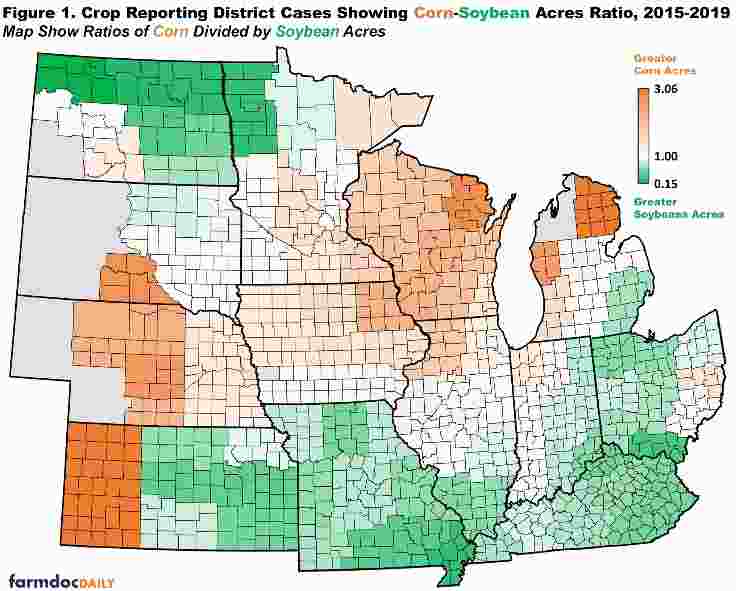By Gary Schnitkey and Krista Swanson et.al
Department of Agricultural and Consumer Economics
University of Illinois
By Carl Zulauf
Department of Agricultural, Environmental and Development Economics
Ohio State University
Relative acres of corn and soybeans vary across Illinois. Northern Illinois has more corn than soybeans acres and southern Illinois has more soybean than corn acres (see farmdoc daily, October 13, 2020). We provide more information on corn relative to soybean acres across the Midwest in this article. As acreages shift across the nation, this will serve as useful background.
Corn and Soybean Ratios Across the Midwest
Acres planted to corn and soybeans were obtained for Crop Reporting Districts (CRDs) from Quick Stats, a website maintained by the National Agricultural Statistical Service (NASS), an agency of the U.S. Department of Agriculture. Planted acres were averaged from 2015 to 2019 for both corn and soybeans. Then, average corn acres were divided by average soybean acres to arrive at ratios of corn-soybean acre ratios. A ratio value of 1.0 means that corn acres equal soybean acres. Values above 1.0 indicate that corn acres exceed soybean acres, typically a result of more corn-after-corn acres in these CRDs, particularly in the heart of the Corn Belt. Values below 1.0 indicate that soybeans exceed corn acres, likely driven by more frequent rotations of soybeans-after-soybeans or use of double-crop soybeans in a rotation with a winter crop in these CRDs.
A map of corn-soybean acre values was prepared that includes all CRDs extending from North Dakota in the northwest, to Kansas in the southwest, to Ohio and Michigan in the east (see Figure 1). To be included in the map, the CRD had to have at least 10,000 acres in each crop. Corn-soybean ratio values above 1.0 are indicated by orange, with darker orange being associated with higher values. Corn-soybean ratio values below 1.0 are indicated by the green, with darker green being associated with lower corn-soybean ratio values. Near white coloring indicates values near 1.0.

Several areas have values above 2.5. The upper part of lower Michigan has several CRDs with values above 2.5. Central South Dakota, central Nebraska, and western Kansas have higher values.
Values above 2.0 are predominant in Wisconsin. A line of CRDs from northeast Wisconsin, northwest Illinois, to northeast Iowa had ratios above 2.0. Then values tend to become lower for CRDs away from this line. Similarly, there is a line of high ratios in central Nebraska and western Kansas. Ratio values tend to decline the further Nebraska CRDs were away from this line in central Nebraska.
Two areas have ratios below 1.0. CRDs in North Dakota, South Dakota, and upper Minnesota have values below 1.0. Ratios also tend to be below 1.0 from Ohio, through eastern and southern Indiana, southern Illinois, Missouri, and eastern Kansas.
For CRDs east of the Mississippi, higher ratios are associated with northern CRDs. Ratios then decrease for more central CRDs, reaching lower levels in more southern CRDs. The same holds for southern Minnesota, Iowa, and Missouri.
Why the differences?
Many factors will influence the overall corn-soybean acre ratios. Two factors explain much of the variability in the I-states (Illinois, Indiana, and Iowa), which are the heart of the Corn Belt:
- Average corn yield — CRD’s with higher average corn yields are associated with higher corn-soybean acre ratios.
- Corn yield relative to soybean yield — CRD’s with higher corn yields relative to soybean yields are associated with higher corn-soybean acre ratios.
As corn yields increase, corn tends to be more profitable than soybeans. Similarly, as corn yields increase relative to soybean yields, corn tends to be more profitable. Both of the above factors directly influence profitability of corn relative to soybeans.
In a regression analysis, the above two factors explain 61% of the variability in corn-soybean acres’ ratios in the I-states. In these states, corn and soybeans are the major crops accounting for over 90% of acres. Irrigation is used on a small number of acres.
Outside the I-states, the explanatory power of the two variables goes down considerably. Other factors likely influencing decisions include:
- Prevalence of other crops. Crops other than corn and soybeans are more prevalent in the Great Plans and Upper Midwest. Wheat has higher acreage shares outside of the I-states and is often used in a rotation with soybeans.
- Prevalence of livestock and dairy. Corn may have more acres where livestock and dairy have traditionally been more prevalent. Wisconsin, for example, has dairy and higher values of corn acres relative to soybean acres.
- Prevalence of irrigation. Irrigation may influence decisions and economics of corn versus soybeans. Corn is more prevalent where more acres are irrigated in Nebraska and Kansas.
Summary
Values of corn-soybean acre ratios vary across the Midwest. In the eastern Midwest, northern CRDs tend to have higher corn-soybean acre ratios in northern regions, and lower ratio values occur in more southern CRDs. The same holds in southern Minnesota, Iowa, and Missouri. Relationships are more mixed in the Great Plains.
Within the heart of the Corn Belt, higher average corn yields and higher corn yields relative to soybean yields tend to be associated with higher corn-soybean ratio values. Also, the prevalence of other crops, livestock and dairy, and irrigation likely impact corn-soybean acre ratio values.
Source : illinois.edu